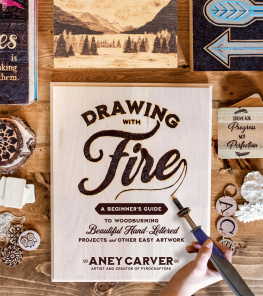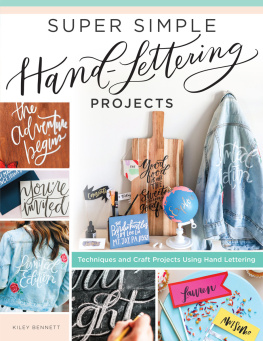Contents
Guide
DRAWING
WITH
Fire
A BEGINNERS GUIDE
TO WOODBURNING
Beautiful Hand-Lettered
PROJECTS and OTHER EASY ARTWORK
 ANEY CARVER
ANEY CARVER
ARTIST AND CREATOR OF PYROCRAFTERS

The author and publisher have provided this e-book to you for your personal use only. You may not make this e-book publicly available in any way. Copyright infringement is against the law. If you believe the copy of this e-book you are reading infringes on the authors copyright, please notify the publisher at: http://us.macmillanusa.com/piracy.
For Clay,
MY BEST FRIEND, BIGGEST FAN AND THE GREATEST PARTNER ANYONE COULD ASK FOR.

Millions of people spend their spare time watching television day in and day out, and most feel unsatisfied. Why? Im convinced that everyone is hardwired to create and be creative in their own way, despite how they may feel about their creative aptitude. It all starts with a moment of inspiration that encourages us to think, I can do that; I can be creative! Of course you can! Now, get up and lets do it. No more excuses about being unable to draw a stick figure or being too intimidated by others talent to try something new. Its time to burn!
Im asking you to take a leap of creative faith with me. Just think how fulfilling and satisfying it would be to turn your TV time into a productive hobby that involves making things with your own two hands. You are capable of creating unique pieces of art that you can be proud of and share with those you love. If youre ready to stoke those creative fires, then lets see what you can achieve.
I first became interested in pyrography after my husband bought a basic woodburning tool from Hobby Lobby to use in his woodworking. He came home and dabbled with it a bit, and one day I got the courage to swipe it from his shop and try my hand at burning an old business logo. In a half hour or soboomI had hand burned a pretty cool logo. It wasnt exactly perfect, but it did stoke my passion to create in a new and interesting way. Now, three years and hundreds of custom art pieces later, pyrography for me is still all about having fun and creating.
In this book, Ill share the what, when, where and how of pyrography. Youll get to create 19 different projects that will spark your confidence while improving your ability to burn. The early projects are simple lettering designs that will help you become familiar with woodburning tools, wood types, heat variables and best safety practices. The projects will become more complex as the book progresses, culminating in advanced shading techniques and landscapes.
You will experiment with different wood types, a variety of burner tips, burning different patterns, adding color and creating shading effects. Every project includes start-to-finish, step-by-step instructions and is accompanied by helpful images and illustrations.
Im excited to introduce you to the endless possibilities of this art form.


I know youd like to jump right in and start burning, but there are some things you need to know before you start. Woodburning is essentially using a glowing hot poker to sear an image into wood, so there are some obvious risks. However, having the right safety knowledge up front and a healthy respect for the tools will help minimize those risks.
Also, understanding the qualities of different wood types is important when youre choosing what to burn. Not all woods are ideal for every project, so knowing where to start is key. Were going to start with woods that have consistent grain patterns and are easily accessible. You can always experiment with other types, but for the purposes of this book, we are only going to cover a few options that you can pick up at your local arts and crafts store or online.
UNDERSTANDING THE GRAINS
There are some woods that are better for burning than others because of their grain pattern. For instance, pine has a distinct grain pattern thats a combination of soft and hard wood. The lighter grain is super soft, whereas the darker grain is hard. The inconsistency of the grain makes it more challenging to burn when you are trying to achieve fine details and straight lines.
Inconsistent grain patterns are not impossible to work with, though; you just need the right tips and heat settings to burn through them. Its common for beginners to struggle and assume they are doing something wrong or arent good at burning, but they likely just need to use a different burner tip or heat setting. So, have no fear of those dreaded inconsistent grains. Ill show you how to burn right through them and create something beautiful.
In contrast, some woods, such as basswood and birch, have a very consistent soft grain that is perfect for burning. These types of wood have a consistent grain throughout, are lightly colored and are easy to source from various retailers. We will be burning basswood, birch and pine throughout the projects in this book. They are perfect for learning pyrography; however, as you gain experience with burning, I encourage you to research other woods and experiment with different options.

Pine wood grain patterns
Pine
As mentioned earlier, pine can be a challenge for pyrographers because of its inconsistent grain pattern. The light grain is very soft and the darker grain is hard.
Your burner will typically cut through soft grain wood like butter and have a difficult time burning through harder dark grains. Since pine contains both hard and soft grains, the result can be an inconsistent burned look or bumpy scorched lines. However, dont despairall you need to master burning pine is the right burner tip and a little practice.
Pine is the perfect wood to learn pyrography with for two reasons. First, its cheap. You can visit your local arts and crafts store, hardware store or favorite online retailers to find a ton of pine wood canvas options in varying shapes and sizes. The availability and affordability of pine puts a great deal of projects at beginners fingertips.
Second, understanding how to burn an inconsistent grain pattern will give you great experience with the heat settings of your burner. Once you get the hang of burning pine, you will quickly start to recognize how much heat you need and how to control the heat to achieve the look you want.














 ANEY CARVER
ANEY CARVER





